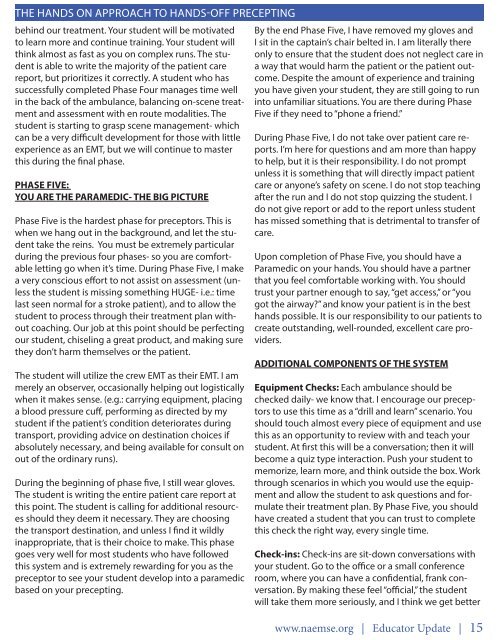Educator Update - Summer 2019
You also want an ePaper? Increase the reach of your titles
YUMPU automatically turns print PDFs into web optimized ePapers that Google loves.
THE HANDS ON APPROACH TO HANDS-OFF PRECEPTING<br />
behind our treatment. Your student will be motivated<br />
to learn more and continue training. Your student will<br />
think almost as fast as you on complex runs. The student<br />
is able to write the majority of the patient care<br />
report, but prioritizes it correctly. A student who has<br />
successfully completed Phase Four manages time well<br />
in the back of the ambulance, balancing on-scene treatment<br />
and assessment with en route modalities. The<br />
student is starting to grasp scene management- which<br />
can be a very difficult development for those with little<br />
experience as an EMT, but we will continue to master<br />
this during the final phase.<br />
PHASE FIVE:<br />
YOU ARE THE PARAMEDIC- THE BIG PICTURE<br />
Phase Five is the hardest phase for preceptors. This is<br />
when we hang out in the background, and let the student<br />
take the reins. You must be extremely particular<br />
during the previous four phases- so you are comfortable<br />
letting go when it’s time. During Phase Five, I make<br />
a very conscious effort to not assist on assessment (unless<br />
the student is missing something HUGE- i.e.: time<br />
last seen normal for a stroke patient), and to allow the<br />
student to process through their treatment plan without<br />
coaching. Our job at this point should be perfecting<br />
our student, chiseling a great product, and making sure<br />
they don’t harm themselves or the patient.<br />
The student will utilize the crew EMT as their EMT. I am<br />
merely an observer, occasionally helping out logistically<br />
when it makes sense. (e.g.: carrying equipment, placing<br />
a blood pressure cuff, performing as directed by my<br />
student if the patient’s condition deteriorates during<br />
transport, providing advice on destination choices if<br />
absolutely necessary, and being available for consult on<br />
out of the ordinary runs).<br />
During the beginning of phase five, I still wear gloves.<br />
The student is writing the entire patient care report at<br />
this point. The student is calling for additional resources<br />
should they deem it necessary. They are choosing<br />
the transport destination, and unless I find it wildly<br />
inappropriate, that is their choice to make. This phase<br />
goes very well for most students who have followed<br />
this system and is extremely rewarding for you as the<br />
preceptor to see your student develop into a paramedic<br />
based on your precepting.<br />
By the end Phase Five, I have removed my gloves and<br />
I sit in the captain’s chair belted in. I am literally there<br />
only to ensure that the student does not neglect care in<br />
a way that would harm the patient or the patient outcome.<br />
Despite the amount of experience and training<br />
you have given your student, they are still going to run<br />
into unfamiliar situations. You are there during Phase<br />
Five if they need to “phone a friend.”<br />
During Phase Five, I do not take over patient care reports.<br />
I’m here for questions and am more than happy<br />
to help, but it is their responsibility. I do not prompt<br />
unless it is something that will directly impact patient<br />
care or anyone’s safety on scene. I do not stop teaching<br />
after the run and I do not stop quizzing the student. I<br />
do not give report or add to the report unless student<br />
has missed something that is detrimental to transfer of<br />
care.<br />
Upon completion of Phase Five, you should have a<br />
Paramedic on your hands. You should have a partner<br />
that you feel comfortable working with. You should<br />
trust your partner enough to say, “get access,” or “you<br />
got the airway?” and know your patient is in the best<br />
hands possible. It is our responsibility to our patients to<br />
create outstanding, well-rounded, excellent care providers.<br />
ADDITIONAL COMPONENTS OF THE SYSTEM<br />
Equipment Checks: Each ambulance should be<br />
checked daily- we know that. I encourage our preceptors<br />
to use this time as a “drill and learn” scenario. You<br />
should touch almost every piece of equipment and use<br />
this as an opportunity to review with and teach your<br />
student. At first this will be a conversation; then it will<br />
become a quiz type interaction. Push your student to<br />
memorize, learn more, and think outside the box. Work<br />
through scenarios in which you would use the equipment<br />
and allow the student to ask questions and formulate<br />
their treatment plan. By Phase Five, you should<br />
have created a student that you can trust to complete<br />
this check the right way, every single time.<br />
Check-ins: Check-ins are sit-down conversations with<br />
your student. Go to the office or a small conference<br />
room, where you can have a confidential, frank conversation.<br />
By making these feel “official,” the student<br />
will take them more seriously, and I think we get better<br />
www.naemse.org | <strong>Educator</strong> <strong>Update</strong> | 15


